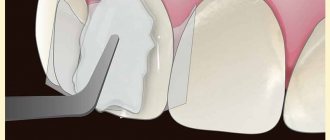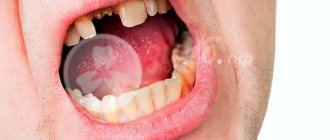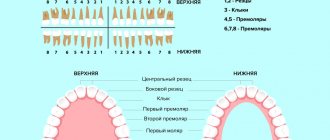The most common operation in dentistry is the removal of lower or upper teeth. Thanks to modern anesthetics and the latest medical equipment, patients at the dental clinic can undergo it without pain and with minimal risk of complications. Doctors do everything possible to ensure that the postoperative period is easy and does not cause significant discomfort in the patient.
Features of lower wisdom tooth removal
“Eights” on the lower jaw appear by the age of 20-25, when the main row of teeth is already formed and fully performs its functions. Therefore, the process of “growing” extreme molars is often not very pleasant and is accompanied by various difficulties, ranging from slight discomfort to serious destructive processes in the jaw. In this case, dentists are guided by the principle “seven troubles - one answer”: no matter what problems a wisdom tooth brings, there is only one way to get rid of them - removal.
Indications for surgery
So when is it necessary to remove a wisdom tooth in the lower jaw? In most cases, indications for surgery are related to certain pathologies of the lower “eight”.
- The wisdom tooth erupted incorrectly
- that is, not straight up, but with a deviation, at an angle to the jaw and neighboring teeth. The slope of the figure eight is:
- distal
- when the “eight” is tilted back, away from the “seven”. In this case, there is a risk of injury to the gums and damage to the roots of the adjacent tooth; - medial
- when the “eight”, on the contrary, is inclined towards the adjacent tooth. This increases the likelihood of damage to the crown part of the “seven” and the development of caries on both teeth; - buccal
- in this case, the wisdom tooth is turned towards the cheek and constantly touches the mucous membrane, causing irritation and hardening of the tissues. This condition can eventually lead to the formation - tumors on the mucosa.
- lingual
- when the tooth is tilted inward, it touches the tongue and damages it, making it difficult to eat and communicate.
- The wisdom tooth has erupted partially or not at all
- dentists call this condition partial or complete retention.
- With complete retention,
the molar does not come to the surface, remaining under the gum, inside the jaw. An impacted tooth may not show itself in any way - in this case, only regular treatment is indicated for control. However, in some cases, a “hidden” molar can cause a lot of problems for the patient, especially if it is located horizontally rather than vertically in the jaw. A lying tooth can damage blood vessels, destroy the jaw bone, provoke inflammation and suppuration under the gum, be very painful, lead to a shift in the dentition, and even cause the appearance of a cancerous tumor. In this case, the patient must have the lower “eight” removed. - With incomplete retention,
the tooth comes to the surface only partially, and this also poses a danger to the patient. A semi-retinated tooth injures the gums, damages the enamel of the neighboring tooth, makes it difficult to access the “seven” for hygiene procedures, and provokes the development of caries. Removing it solves all these problems.
- A wisdom tooth interferes with the normal functioning of the maxillofacial apparatus.
Even if the “eight” erupts smoothly, does not cause inflammation and does not injure soft tissues, over time it can still complicate the patient’s life.
- The appearance of caries.
Due to the difficulty of access, it is not always possible to properly clean the distal molar with a toothbrush. The accumulation of bacteria and food debris leads to caries, which can spread to neighboring teeth. In this case, removal of the lower wisdom tooth is a prerequisite for maintaining the health of the entire oral cavity. - Crowding and displacement of teeth.
Occurs if the volume of the jaw is small and the new molar becomes cramped in the dentition. In this case, the “figure eight” can provoke a shift in the dentition, twisting of the teeth, and malocclusion. After removal everything returns to normal.
We begin implantation of a living tooth
Now it’s time to install our model’s extracted tooth into the socket - a fitting that repeats the shape of the root of the eighth tooth, which we talked about earlier. And the shape of this root does not yet correspond to the sockets of the tooth in which the roots of the six were located. Therefore, the holes at the site of tooth extraction are corrected with a bur until we obtain the required size and configuration for the stereolithographic model, which, in turn, ensures that the space for the new tooth remains intact.
In the photo you see that the tooth model is fitted
. The time from preparation to fitting takes from 5 to 10 minutes.
When we use a stereolithographic tooth, as soon as we remove the problematic tooth, immediately after 10 seconds we begin preparing and installing the model. And only after this we proceed to remove the figure eight, followed by implantation of a wisdom tooth in the place now occupied by the stereolithographic model.
Will the molar replace the removed one?
It is also important when implanting your own tooth that as soon as we extract the donor tooth with its roots and periodontal ligament, we must immediately begin installing it in place of the implanted tooth. Since this place is currently occupied by a sterolithographic model, while my assistant was removing it, I had a few seconds to photograph the figure eight, our donor tooth
:
Please note that there is a periodontal ligament
, which we talked about earlier. Now the implantologist has a strict time limit, no more than 20 minutes. Since if you do not promptly insert a new tooth in place of the removed one, then within 20 minutes this ligament will completely die. The periodontal ligament contains blood vessels, which then help the tooth to osseointegrate and grow into a new place. The tooth receives its nutrition from this ligament.
Therefore, each operation to transplant an extracted tooth is preceded by careful preparation, which includes:
- computed tomography,
- preparation for donor tooth extraction,
- production of an accurate model of the donor tooth on a 3D printer.
How the upper eight, donor tooth, was atraumatically extracted
The tooth we need is impacted upper eight 1.8
, while hidden, is located under the gum. As you can see in the photo, a neat cut has been made at the location of the figure eight. This is what the tooth looks like on a tomography:
The following photo shows how we slightly exposed the tooth for subsequent extraction:
After atraumatic removal of the figure eight, the wound was carefully sutured:
And now we want to show you how accurately the tooth model replicates the root of the figure-eight tooth we implant:
Look at the precision of manufacturing. Almost identical configuration and size of the model! The technology of tooth transplantation and implantation of living teeth has largely become possible thanks to digital dentistry, using:
- computed tomography,
- stereolithography technologies,
- digital 3D scanning,
- printing models on a 3D printer.
As a result of wisdom teeth transplantation, we receive the so-called wisdom teeth in place of the removed problematic tooth. "tooth of a new generation" The benefits of eight teeth in the age of digital technology are becoming obvious and in demand.
Implantation of a living tooth in place of the lower six
You see that the artificial tooth has been removed, and in its place a living impacted tooth-eight, which has been hidden in the gum all its life, has been transplanted. Figuratively speaking, “a child was born and immediately began his life in a new place.” In any other case, this eight would have been removed someday and would have been of no use. But in this case, its role in restoring the patient’s dentition is the main one, and thanks to the presence of a wisdom tooth in good condition, such a jewelry operation became possible.
The transplanted tooth is sutured and fixed tightly in the gum so that there are no empty spaces around its root.
The installed tooth is still slightly short of normal bite, but in the future it is planned to cover this tooth with a ceramic crown.
In 2 weeks
A general practitioner from the Research Center removed the nerves in the implanted tooth under a microscope, and the canals were carefully sealed. In general, the nerve in the transplanted tooth-eight can take root only if the patient is under 20 years old. This is the age when the roots of the wisdom tooth are not yet fully formed. And if the root has formed, then there is no longer a growth zone and, accordingly, it has no growth potential.
When is it better not to remove a wisdom tooth?
It seems that removing the lower wisdom tooth is the best solution to all problems, but this is not always true. In many patients, the eruption of “eights” occurs without complications, and in the future these teeth do not cause inconvenience, so there is no need for surgery. Also, you should not pull out your lower wisdom tooth if:
- dental prosthetics are planned and the third molar can become a support for a bridge;
- "seven" is missing. In this case, the wisdom tooth will take its place;
- caries affects only the upper part of the wisdom tooth. Then, instead of a traumatic removal operation, you can perform a regular filling, the price of which will be lower.
Relative contraindications to wisdom tooth removal are:
- infectious and inflammatory processes affecting the oral cavity
- for example, periodontal disease. In this case, you first need to stop the inflammation and take a course of antibiotics, and only then proceed to remove the molar; - respiratory diseases
- influenza, ARVI. They can provoke postoperative complications; - pregnancy and breastfeeding;
- cardiovascular diseases
in the acute stage.
Complications
When lower teeth are removed, the tissues that surround them are injured. This cannot be avoided, since the jaw apparatus very securely holds the roots in the hole.
Therefore, after the intervention, the patient sometimes experiences:
- Edema. Caused by partial destruction of tissues that are located near the wound. As a rule, it goes away on its own in a few days.
- Swelling of the gums, gumboil. Painful symptoms can be relieved by applying cold compresses.
- Increased body temperature. It is considered a normal reaction to inflammation. Lasts up to three days. You need to take anti-inflammatory and antipyretic medications prescribed by your dentist.
- Pain. Usually the gums and cheek hurt. Also, discomfort can spread to the throat, lower and upper jaw. They are explained by damage to the periodontal nerves and tissues and gradually go away on their own.
- Local bleeding. Most often, blood flows only immediately after removal, but sometimes it begins to re-release several hours after the intervention. Then you need to apply a sterile gauze swab to the hole and gently bite it.
- Discharge of pus. Speaks of infection and requires urgent medical consultation. Most often, this complication is encountered by people who ignored the doctor’s orders and were inattentive to the condition of their oral cavity during the recovery period.
- Paresthesia or numbness of part of the face or tongue. It is a consequence of difficult removal. It is more common if a wisdom tooth has been pulled out. Usually the symptom goes away within two weeks.
- Dry hole. Normally, a small blood clot forms immediately after surgery. If it is not there, the place is left uncovered, they call it a dry socket. It is considered a complication because the wound remains open to infection. At the same time, a person may experience ear or throat pain, alveolitis, and inflammation of the gums. To avoid these problems, you need to see a doctor. He will put a special wound-healing gel into the cavity.
Dentists carry out treatment following established norms and rules, using disposable sterile instruments and prescribing an effective treatment regimen for each client, which makes the postoperative recovery process quick and painless.
Differences between figure eight removal on the lower and upper jaws
Removing a third molar in the lower jaw is considered a more complex procedure than removing a wisdom tooth in the upper jaw for a number of reasons.
- Access to the lower molars is more difficult than to the upper ones.
- The lower jaw bone is more massive and dense, it holds the tooth more firmly.
- The pressure on the teeth of the lower jaw is greater than on the upper teeth, so the roots of the lower molars are more developed. In addition, due to improper growth, they can be curved or misaligned.
- It is easier to perform local anesthesia from above, and anesthesia from the bottom often involves the muscles of the face, tongue, throat and ears.
All this makes the procedure for removing the 8th tooth from below a difficult task. If the upper molars in most cases can be easily rocked and pulled out with special forceps, then the lower molars often have to be removed in parts, cutting with a drill.
Features of implantation of the 7th upper tooth
Due to the anatomical features of the upper and lower jaws, the timing of implantation differs.
The upper jaw is subject to less stress when chewing. The bone tissue is looser compared to the lower row. Therefore, the implant takes 1-2 months longer than from below. Above are the maxillary sinuses, the infraorbital foramen and the facial nerve. If the implant is inserted incorrectly, there is a risk of damage, which increases the complexity of the procedure.
In case of sinusitis, sinus cyst, inflammation of the nasal mucosa, surgical intervention to implant a titanium root is not performed until the disease is eliminated.
If the upper molar is missing for a long time, the patient is indicated for a sinus lift. The procedure compensates for the lack of bone tissue by raising the bottom of the maxillary sinus and filling the space with synthetic material. The operation is performed open or closed.
In the first case, the procedure is carried out in two stages. The doctor builds up the jawbone, and after the osteoplastic material has fused with the tissues, an artificial root is implanted.
A closed sinus lift is combined with implant installation. The technique is less traumatic and reduces the duration of treatment. Loading of the artificial root with a crown is carried out after osseointegration.
Easy removal
If the wisdom tooth has erupted correctly, grows evenly and has straight, untwisted roots, then there is every chance of getting by with a simple operation, which is carried out in 4 stages.
- Diagnostics
, including examination and x-ray, allows the doctor to get a more accurate idea of the upcoming operation. - Anesthesia.
Generally, local anesthesia is used for simple wisdom teeth removal. - Tooth extraction.
The doctor applies forceps, gently rocks the tooth and removes it using a special tool - an elevator. If fragments of roots remain in the hole, they are also carefully removed. - Treatment of the hole and suturing of the gums.
Antiseptic and anti-inflammatory solutions are used. In some cases, stitches are placed to protect the wound from bacteria, and the patient is sent back for rehabilitation. As reviews show, in the case of simple removal it takes very little time.
Complex removal of the lower wisdom tooth
Impacted, semi-impacted, horizontal teeth, as well as teeth with curved, twisted, branched roots, are much more difficult to remove. Preparation for such an operation is similar to uncomplicated cases (although general anesthesia is sometimes used), but the extraction of the tooth itself requires additional effort from the doctor. Almost always you have to resort to cutting the gums, and the tooth is cut with a drill and removed in parts. Then the gum is sutured. In general, the volume of intervention during complex removal of an impacted wisdom tooth is always greater than during simple removal.
Is it painful to remove a lower wisdom tooth?
The question worries everyone who is planning to get rid of the “eights,” especially if the case is complex. Patients’ concerns are understandable: after all, wisdom tooth removal is a full-fledged operation. However, there is no need to be afraid of pain. During the process of cutting the gums, sawing and extracting the molar, the patient may feel pressure, vibration or stretching, but nothing more: modern anesthetics make the process absolutely painless.
After the anesthesia wears off, pain may become more intense, so the doctor will definitely prescribe painkillers to make the recovery period as comfortable as possible. If healing proceeds without complications, they will have to be taken for 2 to 5 days, depending on the extent of the intervention. As the soft tissues recover, the pain gradually becomes more tolerable and soon disappears completely.
Consequences and possible complications
It is necessary to separate the consequences of the operation and complications after it. All patients experience consequences to one degree or another - this is a normal reaction of the body to intervention, but it is better to avoid complications.
Consequences include:
- painful sensations;
- bleeding gums within 3-5 hours after surgery;
- swelling of the gums, cheeks;
- bruises on the face in the area of intervention;
- rise in temperature.
Complications may be as follows:
- prolonged bleeding
- due to the fact that the tissues around the lower “eights” are saturated with blood vessels. In this case, the doctor may apply additional hemostatic measures; - alveolitis
- inflammation of the wound surface associated with infection in the hole. It is characterized by the following symptoms: fever, bad breath, swelling, pain. Requires additional wound treatment and antibiotics; - paresthesia
- loss of facial sensation. Usually the lips, cheeks, and tongue suffer - they do not feel touch, do not distinguish between hot and cold. Loss of sensitivity is associated with damage to the facial nerve and may go away on its own within 1-2 weeks, but in some cases requires additional therapy; - dislocation of the mandibular joint
is a rare but possible complication associated with excessive efforts made by the surgeon to extract the tooth. The dislocation can be corrected immediately.
Attention!!!
Removing a problematic lower molar is a full-fledged operation, so special attention should be paid to the recovery period. It is necessary to strictly follow the doctor’s recommendations and carefully care for the oral cavity, then the likelihood of developing the complications described in the previous section will be minimal. Standard assignments include:
- taking painkillers and antihistamines
- antibacterial rinses
- cold compresses on the cheek in the area of intervention (reduce hematomas and reduce the risk of re-bleeding)
- prohibition on eating during the first hours after surgery
- ban on smoking, drinking alcohol, physical activity
- ban on visiting the sauna and swimming pool, taking hot baths
If the doctor did not make mistakes during the operation, and the patient does not violate the recovery regime, then very soon there will be no trace of unpleasant sensations.








